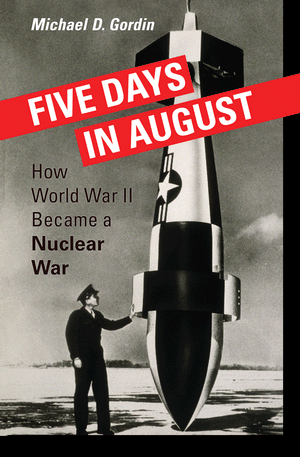
Michael D. Gordin. Five Days in August: How World War II Became a Nuclear War. Princeton: Princeton University Press, 2007. 264 pp. $24.95 (cloth), ISBN 978-0-691-12818-4.
Michael Kort. The Columbia Guide to Hiroshima and the Bomb. Columbia Guides to American History and Cultures Series. New York: Columbia University Press, 2007. 464 pp. $46.50 (cloth), ISBN 978-0-231-13016-5.
Andrew J. Rotter. Hiroshima: The World's Bomb. The Making of the Modern World Series. Oxford: Oxford University Press, 2008. Illustrations. 371 pp. $29.95 (cloth), ISBN 978-0-19-280437-2.
Nash writes:
These three books on the atomic bombings of Japan represent an apple, an orange, and a banana for comparison purposes. One is a reference work with primary sources, one is a synthetic overview, and one is a narrowly focused monograph. Together, however, they do reflect the diversity of the useful scholarship still being produced despite the admitted vastness of the existing literature on "The Bomb."
Most innovative of the three is the reference work, Michael Kort's Columbia Guide to Hiroshima and the Bomb. It joins at least a half-dozen other titles in the same series on a wide variety of historical topics. Other reference works and document readers of course exist, but none tries to do what the Columbia Guide does.[1] It begins with a seventy-five-page "Historical Narrative," accessible to the lay reader, which briefly describes the debate over Hiroshima and then traces events from the launching of the Manhattan Project through the Japanese surrender. Part 2 devotes thirty-five pages to ten "Key Questions and Interpretations," such as "Was the Policy of Unconditional Surrender Justified?" Part 3, "Resources," uses thirty pages to provide a chronology, glossaries of terms and names, and a bibliography of primary and secondary sources. The last section presents over two hundred pages of primary documents arranged in seven sections: American civilian documents; American military documents; summaries of Japanese diplomatic cable traffic obtained via MAGIC codebreaking; Japanese government and military documents and diary entries; Japanese surrender documents; key sections of the U.S. Strategic Bombing Survey, including portions of interrogations of Japanese officials; and postwar statements by Japanese officials collected by the U.S. Army historical division.
The Columbia Guide largely succeeds in achieving its goal, "to make available to a wide audience the primary source materials necessary for making a reasoned judgment about the American decision to use nuclear weapons against Japan during World WarII" (p. xiii),
though Nash goes on to offer a critique. Of Rotter's Hiroshima, he writes:
This is also one of a series, in this case Oxford University Press's The Making of the Modern World. In a field of secondary-source-synthesizing overviews already plenty crowded, Rotter's stands out.[5] He covers what one might expect: the origins of the atomic bomb; the atomic programs of World War II's major combatants; the bombings of Hiroshima and Nagasaki; the early Cold War and development of the hydrogen bomb; and, in a final chapter, brief capsule-histories of subsequent cases of nuclear proliferation....
Michael D. Gordin's brief Five Days in August, as its title suggests, is by far the most narrowly focused of the three books. By shedding unusual light on the period August 9-14, 1945--that is, between the destruction of Nagasaki and the Japanese surrender--Gordin quite usefully restores a sense of contingency to the history of the bomb. That is, he tells "the story of how the atomic bomb was thought about and treated before anyone could claim that the bomb had ended the war, simply because the war was not yet over" (p. 10).
Read the full review here.